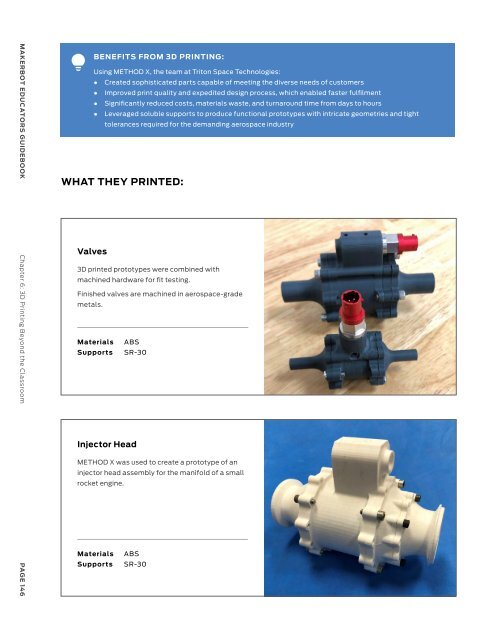MakerBot Educators Guidebook 3rd Edition
Create successful ePaper yourself
Turn your PDF publications into a flip-book with our unique Google optimized e-Paper software.
MAKERBOT EDUCATORS GUIDEBOOK Chapter 6: 3D Printing Beyond the Classroom<br />
PAGE 146<br />
BENEFITS FROM 3D PRINTING:<br />
Using METHOD X, the team at Triton Space Technologies:<br />
● Created sophisticated parts capable of meeting the diverse needs of customers<br />
● Improved print quality and expedited design process, which enabled faster fulfilment<br />
● Significantly reduced costs, materials waste, and turnaround time from days to hours<br />
● Leveraged soluble supports to produce functional prototypes with intricate geometries and tight<br />
tolerances required for the demanding aerospace industry<br />
WHAT THEY PRINTED:<br />
Valves<br />
3D printed prototypes were combined with<br />
machined hardware for fit testing.<br />
Finished valves are machined in aerospace-grade<br />
metals.<br />
Materials ABS<br />
Supports SR-30<br />
Injector Head<br />
METHOD X was used to create a prototype of an<br />
injector head assembly for the manifold of a small<br />
rocket engine.<br />
Materials ABS<br />
Supports SR-30<br />
SECTION 6.3<br />
ROBOTICS<br />
Powering the Future of Manufacturing<br />
The future of manufacturing heavily depends on<br />
new and smart technologies - such as robotics,<br />
automation, artificial intelligence, machine learning,<br />
3D printing, and more - to advance engineering and<br />
production. 3D printing can be used to create a more<br />
streamlined design process, enhance and customize<br />
robotic solutions, and innovate part production.<br />
MAKERBOT EDUCATORS GUIDEBOOK PAGE 147<br />
PAGE 147





